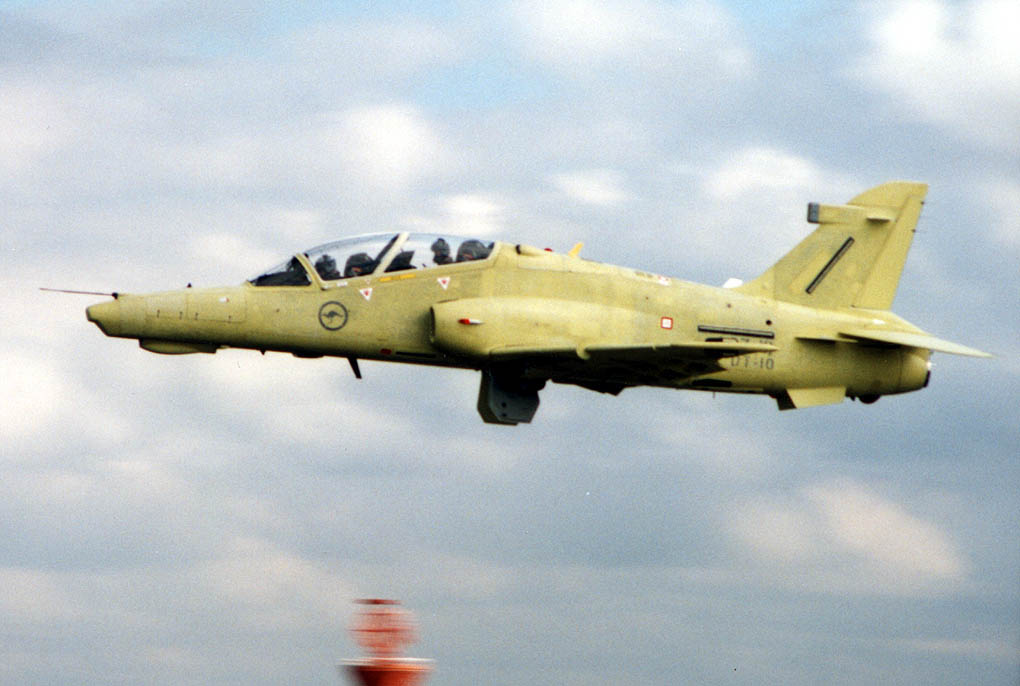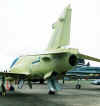|
RAAF
BAE Hawk 127LIF
Part
Two - Hawk in Australia
Text
and Photos by Darren Mottram

|
BAE
Hawk 127LIF
First flight of Australian assembled Hawk
Lead-in Fighter aircraft
BAE SYSTEMS Williamtown, NSW
12th May 2000 |
On 7 April, 2000, the RAAF held a parade and display at
Williamtown for invited guests to celebrate the reformation of 2 Sqn which will
fly the RAAF's new AWACS aircraft.
As a part of this event, BAE SYSTEMS provided one of the Hawk
127 LIF aircraft from the final assembly facility, also at Williamtown, to allow
those present to get a first look at the new trainer. I was able to accompany
the aircraft for the display and, as it was a semi-public event, able to take
photographs that I can now share with you all here.
Please note that the aircraft was rather incomplete on this date
and, as such, is not definitive of the final look of the Hawk. It does, however,
give a relatively detailed first look considering the limitations at this stage
in the program.
On 12 May, 2000, the first flight of an Australian-assembled
Hawk took place.
RAAF roundels and serial number (A27-10) were temporarily
sprayed directly onto the yellow-green primer coat resulting in a very unique
looking aircraft!
The title photo and the two last photos depict the flight, and a
close-up of the temporary fuselage roundels.
17
photographs are captioned and thumbnailed below. To view an image at its full size, click on the thumbnail. To return
to this page, click the "back" arrow on your browser.
 |
Appropriately, the new Lead-In-Fighter was displayed alongside an
example of the Aircraft it is to replace, the MB-326H Macchi. This shot
provides a good comparison of the layout and features of the two aircraft.
|
 |
Various views of the nose. The forward formation light can be seen just
below, and in front of, the intakes. The colour of all the undercarriage
legs, door interiors, speed brake well and intake interiors is light grey
(approximately FS16440). The interior of the wheel wells themselves are
gloss white. |
 |
|
 |
|
 |
Views of the wings, centre fuselage and main undercarriage. On the
wings can be seen the various airflow modification devices such as vortex
generators, strakes and stall wedges. Notice how the outer airflow strakes
have also been used to carry the wingtip formation lights. The fitting on
the wingtip is the fairing used when sidewinder launch rails are not
carried. On the trailing edge can be seen the attachment points for the
flaps and ailerons. |
 |
 |
|
 |
|
 |
Rear fuselage and empennage. The open airbrake can be seen between the
two ventral strakes. Notice that there are two, parallel, formation lights
on the rear fuselage. Also visible in these views are the airflow
modification devices fitted in front of the tailplanes. Another point of
interest in these views is that the various access panels, panel lines and
the formation lights on the rear fuselage are *not* parallel to each
other. |
 |
 |
|
 |
|
 |
These three photos show some of the other aircraft which were present
on the day. An F/A-18 from 3 Sqn. Note the (relatively) new underwing
carriage of sparrow missiles. The Neptune operated by the Historic
Aircraft Restoration Society from Bankstown in Sydney. One of the RAAF's
(still) new C-130Js from 37 Sqn at Richmond, also in Sydney. |
 |
 |
|
 |
The first completed Australian-manufactured Hawk on 12 May, 2000 |
 |
Hawk Take Off - courtesy BAE SYSTEMS |
Text and Images Copyright © 2000 by Darren Mottram
Except Final Image Copyright © 2000 by BAE SYSTEMS
Page Created Sunday, 14 May 2000
This page last updated on Friday, 18 May 2001
Back to The
Reference Library
Back to HyperScale
Home Page
|
Home |
What's New |
Features |
Gallery |
Reviews |
Reference |
Forum |
Search